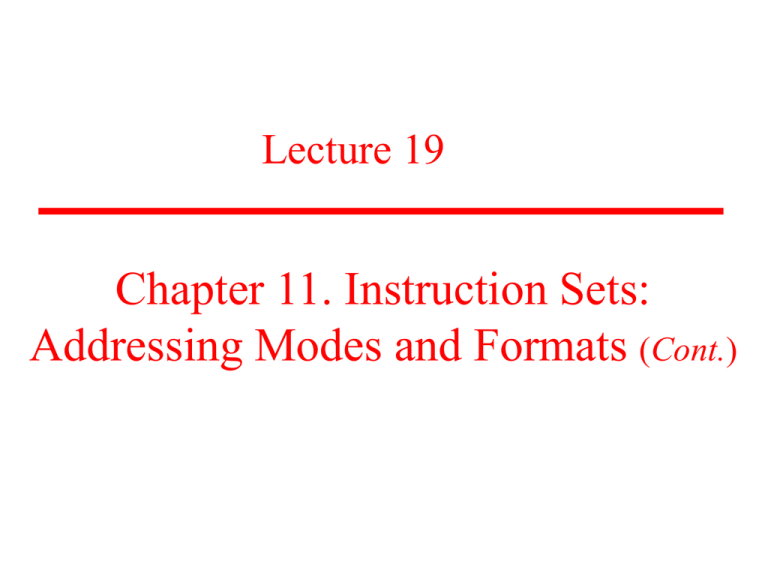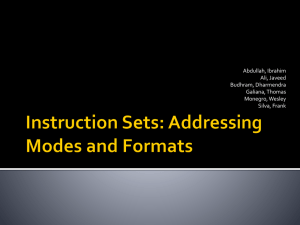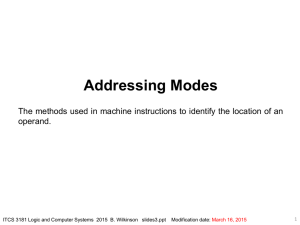Addressing Modes
advertisement

Lecture 19 Chapter 11. Instruction Sets: Addressing Modes and Formats (Cont.) Addressing Modes 1. Immediate 2. Direct 3. Indirect 4. Register 5. Register Indirect 6. Displacement 7. Stack 5. Register Indirect Addressing • c.f. Indirect addressing. • EA = (R) • Operand is in memory location pointed to by contents of register R. • Large address space (2n). • One fewer memory access than indirect addressing. 6. Displacement Addressing • EA = A + (R) • Address field holds two values: A = base value, R = register that holds displacement, or vice versa. 6. Displacement Addressing – Interpretations • Relative Addressing — R = Program counter, PC — EA = A + (PC) — i.e. get operand from A locations from current location pointed to by PC. A is in 2’s comp. representation. — c.f. Locality of reference & cache usage. • Base-Register Addressing — R holds a base address. — A holds displacement from base address. — R may be explicit or implicit (e.g. segment registers in 80x86). • Indexed Addressing — A is a memory address — R holds displacement (index register). — EA = A + (R). — Good for accessing arrays – EA = A + (R) – R++ 6. Displacement Addressing – Autoindexing • Typically, there is a need to increment/decrement the index register after each reference to it. • EA = A + (R) (R) ← (R) + 1 • If certain registers are devoted exclusively to indexing autoindexing is done automatically. • Sometimes both indexing and indirection are provided. • Preindexing: indexing is done before the indirection. —EA = (A+(R)) (multiway branch table) • Postindexing: indexing is done after the indirection. —EA = (A) + (R) (accessing fixed-length blocks) 7. Stack Addressing • Operand is (implicitly) on top of stack. • e.g. —ADD Pop top two items from stack and add Addressing Modes – Summary Pentium Addressing Modes • Virtual or effective address is offset into segment. —Starting address plus offset gives linear address. —This goes through page translation if paging enabled. • Addressing modes available —Immediate —Register operand —Displacement —Base —Base with displacement —Scaled index with displacement: scaling different word sizes. —Base with index and displacement: 2D arrays, array in SF —Base scaled index with displacement: different word sizes —Relative Pentium Address Calculation General-purpose register Pentium Addressing Modes – Summary PowerPC Addressing Modes – Summary General-purpose register PowerPC Addressing Modes • Load/store architecture — Indirect – Instruction includes 16-bit displacement to be added to base register. – Can replace base register content with new address. — Indirect indexed – Instruction references base register and index register. – EA is sum of contents. • Branch addressing — Absolute – 24- and 16-bit immediate value for unconditional and cond. – Extended to 32-bit value: add 2 0’s to LS end, sign-extend. — Relative. — Indirect. • Arithmetic Instructions — Operands in registers or part of instruction. — Floating point is register only. PowerPC Indirect and Indirect Indexed Addressing Modes Instruction Formats • Layout of the bits of an instruction. • Includes opcode and (implicit or explicit) zero or more operands. • Each operand is referenced using some addressing mode. • Usually more than one instruction format in an instruction set. Instruction Length • Affected by and affects: — Memory size. — Memory organization. — Bus structure. — CPU complexity. — CPU speed. • More opcodes, operands, and addressing modes easier/flexible programming. • Large range of addressable memory is desirable. • Tradeoff between powerful instruction repertoire and saving space. • mem. transfer length = Inst. length (or multiple). • CPU exectues instr. Faster than it can fetch them use short instructions. • Multiple of char. Length and = length of fixed-point numbers. Allocation of Bits (1) • Tradeoff between # of opcodes & power or addressing. • Variable-length opcodes (min. opcode length is needed). • Number of addressing modes —Implicit: opcode particular addressing mode. —Explicit: some bits to specify addressing mode are needed. • Number of operands —Fewer addresses longer programs. —Each operand could need its mode indicator, or just one. • Register versus memory —Accumulator no bits, but longer program. —More registers used instead of mem. less bits. Allocation of Bits (2) • Number of register sets —e.g., a set for data and another set for displacement. —2 sets of 8 registers 3 bits are needed, opcode determines which set. • Address range —Direct addressing is rarely used. —Displacement addressing: large displacement would require more bits. • Address granularity —Byte addressing vs. word addressing. —Byte addressing is convenient for characters, but needs large number of bits. Pentium Instruction Format • • • • Inst. prefix: LOCK or repeat prefixes to repeat operations on strings. # in CX. Segment override: which segment register to use. Operand size override: specifies 16- or 32-bit operands. Address size override: specifies 16- or 32-bit addresses displacement size. PowerPC Instruction Format (1) PowerPC Instruction Format (2) Reading Material • Stallings Chapter 11, pages 386-397, 404-408











